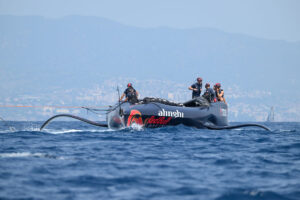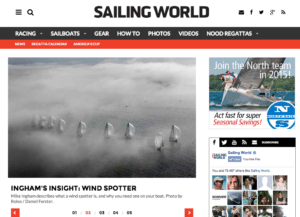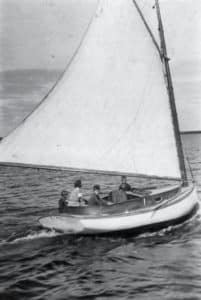Once the Finals started, I no longer had the luxury of a taped television performance and the option to reread lines when I erupted into a coughing fit. We were broadcasting [the 31st America’s Cup] live, so I had to employ every trick to control the coughing while on the air: lozenges, Listerine strips, whatever it took. The words “going to commercial” were music to my ears. During the commercials I’d cough wildly and puke in a bucket. The red blotches, the night sweats—they continued to plague me. The fatigue was getting worse. I was also doing radio spots and writing reports for ESPN.com. It was agony to keep pace. Worse, it was confusing. Why was my health disintegrating?
[Returning from Auckland after the Cup Finals] The minute the airplane wheels touched the runway in Baltimore, the clock was ticking. Leaving New Zealand later than expected due to all the weather delays, I was under enormous time pressure to prepare a show on the Cup and take it on the road. Before the Cup Finals, I had lined up a speaking tour of 63 cities. People were eager to hear the story of the America’s Cup, and I wanted to give them all a great show.
I headed right into an editing studio outside Baltimore with all the raw material, including Cup footage from New Zealand and the news reports I’d written. The end result was a good show, probably the best I’d ever done. I love speaking to a crowd, looking out at a sea of eyes and giving them all a vision of the sport with exciting footage, music, funny stories, and the kinds of insights about the sport and its players that sailing fans don’t get from news articles. At the beginning of my speaking career, I wasn’t always excited about getting up in front of a crowd. But I learned to be prepared, to have good notes and some good stories. Now, I enjoyed it immensely—whether I was speaking to a crowd of 50 or 500. Once I returned from Auckland, I studied the schedule: Chicago, San Francisco, Detroit, Annapolis, New York City, southern California, Cleveland. A lot of people were waiting for a show about the America’s Cup that had just concluded in faraway New Zealand—whether they were a group of young Sea Scouts or Manhattanites heading to a night out at the Union League Club. I hadn’t cancelled a speaking engagement in 30 years, and I was not about to start now. If I could just get through this next rush of deadlines and get this show on the road, I’d find a window of time to rest afterward.
But once I got on the road, the lectures became increasingly harder and harder to do. Thank goodness I had years of experience. I could modulate my voice and cover up the coughs; I’d take an inhaler 10 minutes before I got introduced and use different kinds of lozenges and Listerine strips. I’d do everything I could not to cough. I’m usually a fast walker and can get through airports quickly. Now, I had to make allowances for taking longer, and walked slowly through airports. Once I reached my destination, I rested whenever and wherever I could: a couch in a yacht-club manager’s office, a comfortable chair in a secluded spot. It got to the point when once the program ended, I had to get right back in bed. It was hell.
My friend Chuck Inglefield hosted me for a speaking engagement at the Cleveland Yachting Club on April 10. I had just finished and was quickly packing my things up while people were still milling around. A longtime acquaintance, Lorry Malm, came up to say hello. He was a doctor I met back in the 1970s. He reminded me that I’d written a letter for his son, a good sailor, when he applied to Stanford. But we didn’t talk about old times. He looked concerned.
“You don’t look very well,” he told me. “Would you allow me to give you an examination tomorrow?”
Early the next morning, he came by the house where I was staying. He looked me over and told me, “You know what, you need to come down to my clinic.”
So I went down to the clinic, and we did all the tests. Four hours of tests: blood work, X-rays, scans. And after four hours we met in his office, that look of concern still on his face.
“I don’t know what is wrong with you, but I can tell you this, you are very ill and you are out of gas.”
He instructed me to stop what I was doing and get to a hospital. He offered to admit me there, in Cleveland, or I could plan to go home to Baltimore and get myself admitted. This was a Friday morning, but I had a talk scheduled for Las Vegas Friday night, a talk at Mentor Harbor YC outside Cleveland on Saturday, and a Sunday talk in Erie, Pa. I listened to him carefully and reasoned: If I go home today, I’m not going to get anything done until Monday anyway. So I decided to persevere.
Getting out to Las Vegas almost killed me. I could barely walk to my hotel room. I got through my presentation and got myself back to Cleveland. The next day I spoke in Erie and flew back to Baltimore Sunday night, exhausted. On Monday, more tests started. This time, a biopsy was also performed. After 10 days, I met with Dr. Yudhishtra Markan for results. When I arrived at his office, he looked somber. He slowly walked over to shut the office door, and then he sat down with a stern expression. He took a deep breath, leaned into his desk, and gave me the news: You have lymphoma. Non-Hodgkins lymphoma. That was the reason my health was failing. That was the reason my lymph nodes were popping out of my skin, and the reason why I woke up drenched with sweat, and the reason why I was continually exhausted and running on empty. I had a tumor in my stomach the size of a softball. A high percentage of the people treated for the disease can survive, Dr. Markan told me, for a period of time. It could be five years; it could be fifteen. Unfortunately it is a disease that comes back, in everybody. “Now we hope we have more powerful drugs when it does come back . . .”
I was listening to him, but as he spoke I wondered: What is worse, me sitting here listening to my doctor across a desk, or him telling me? Either way, this was one tough conversation. I actually got a little teary hearing this: the five to fifteen years, the fact that you can’t get rid of it, the fact that it returns. In every single case, it returns. Dr. Markan told me to clear my calendar and to prepare. The treatments, he warned, would be harsh. I had lectures and things to do, but deep down, I knew I had to get my head around this news.
In the days that followed, so many thoughts passed through my mind. For one, this was a little ironic. For 10 years, I’d been chairman of the Leukemia & Lymphoma Society sailing regatta series. We’d grown that series from one event in Annapolis in 1993 that raised $30,000 to a national circuit of events that had raised some $28 million. (By 2011 the total was nearly $40 million.)
How ironic that I was now one of those very people with this illness. I wanted my own doctor and sailing friend, Glenn Robbins, to be part of my team, to help me digest all the information being put before me—the science and the treatment options. I read a lot about the disease, learning as much as I could. I wanted the most aggressive treatment my body could survive. Only 11 days after my diagnosis I had my first treatment, and Dr. Markan was right. It was harsh. There was one question I had to ask Glenn. I was not sure I wanted the answer—but I had to know.
“If I hadn’t come in for these tests, if I’d just kept going, how long would I have lasted,” I asked.
“About 30 days . . . Then you would have gone out,” he said.
By early May, I had my work affairs in order. My assistant, Kathy Lambert, helped clear my calendar, and I sent an email to friends and colleagues. I gave them the news and told them that, for the next six to eight months, I’d be receiving chemotherapy to battle back from this disease.
“I’m going to be in a quiet period now,” I wrote. “Apparently, the treatments are hard. Sorry to give you this report. My spirits are good. I hope to be around the waterfront later this summer.”
And then psychologically I moved on to face the next chapter of my life. It was as if a curtain went down. But it wasn’t long after the send button was pushed that responses started flooding in. E-mails arrived from all over the world. The switchboard at my company in Annapolis, Jobson Sailing, lit up like a Christmas tree. Kathy fielded all the calls from sailing friends, from acquaintances, from colleagues. Some cheered me on, telling me how they had battled a life-threatening disease and won. Some were messages of sympathy and encouragement.
I didn’t really digest them all, but I do remember the messages that were most encouraging. They didn’t talk about cancer or recovery. Those people simply reminded me of all the good times we’d had on the water in the past, and how there would be more. And that is exactly what I needed to hear. I needed to remember the good times, and to hope there would be more.
This excerpt appeared in the May 2011 issue of Sailing World.










